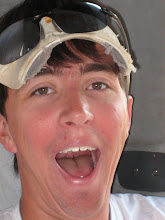
Ritual bath outside the Temple Mount which Jews would have used to become ritually cleansed.

The Double Gate on the Southern Wall of the Temple Mount. The frame and structural support are from the original construction. Jesus would more than likely have passed through this gate.

The Garden Tomb, not where Jesus was buried although a very nice tomb from Old Testament times. Supposedly there is a cross carved into the side but I think you can find most shapes with all the cracks.

Day 4 seemed a little easiet than the earlier days. We began at the Souther Temple Mount Excavations. Here we saw the remnants of what the area around the Temple Mount would have looked like the days of Jesus including part of a broken arch which would have had a staircase leading into the Temple mount, also the stairs on teh southern side which most people would have used for access with two gates a double gate, which is mostly blocked but half of one of the two entries in the gate. Some of the original stones from the gate are there although it has been fixed and blocked, this gate would have been the exit from the Mount. The other gate, a triple gate was the entrance, only one of the original stones is left. The stone at the left edge of teh gate is an original frame stone. There were other excavations here from teh Hasmonian (Maccabees) period that were interesting but not necessary for a Biblical understanding.
After this we went to the Israel museum and say a model, 1/50 size, of 2nd Temple Period(Herod to Roman Destruction in 70 AD). Also at this museum we saw the Shrine of the Book which has portions of the Dead Sea Scrolls. We missed the lare portions of the most important scroll, the Isaiah A scroll by 3 days, meaning on my free day on Monday I will go and see it.
From the museum we went to tombs dating back to the Old Testament. The tombs were very interesting because they had slabs where they would lay the body and then after one year they would come back and take the bones and place them in another area of the tomb so that they could place other family members on the slabs. It was in one of these tombs that they found the oldest manuscript of Scripture, a small silver scroll of the High Priestly prayer in Deuteronomy dating back to 700 BC. We then went to another tomb which is the only tomb from Jesus' time that has been found with a rolling stone.
From the tombs we had a quick, late lunch on our way to the garden tomb and Gordon's calvary. Gordon's calvary is a possible site of the crucifixion. A man named Gordon went to Jerusalem in the 1800s and was appalled at the Church of the Holy Sepulchre and found it inside of the sitiy walls, and the Bible says he was crucified outside of the city walls. So Gordon thought that the cross and tomb could not have been at this site. He then went around looking for other possible locations and found a hill outside of the gates that on the side looked like a skull, which matched well with his understanding of the Bible. Also on this same hill is a tomb which has a trough for a stone to roll and a tomb. The problem with this being the site of Jesus death and resurrection is first of all a very late tradition, only about 150 years, the Church of the Holy Sepulchre would have been outside of the city walls in Jesus' day, and the tomb dates to the Old Testament. It is a nice tomb and a good presentation by Christian guides which are rare in Jerusalem. Many Protestants have held strongly to this site in recent years but contextually the case for the site as the actual place of Jesus death and burial is very unlikely. It is however likely that it could be the location of Stephen's stoning in Acts.




No comments:
Post a Comment